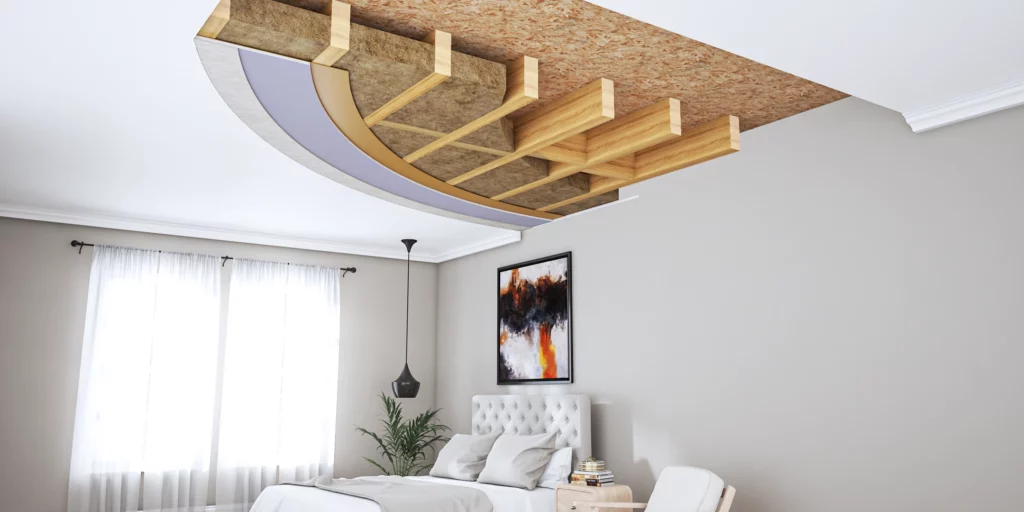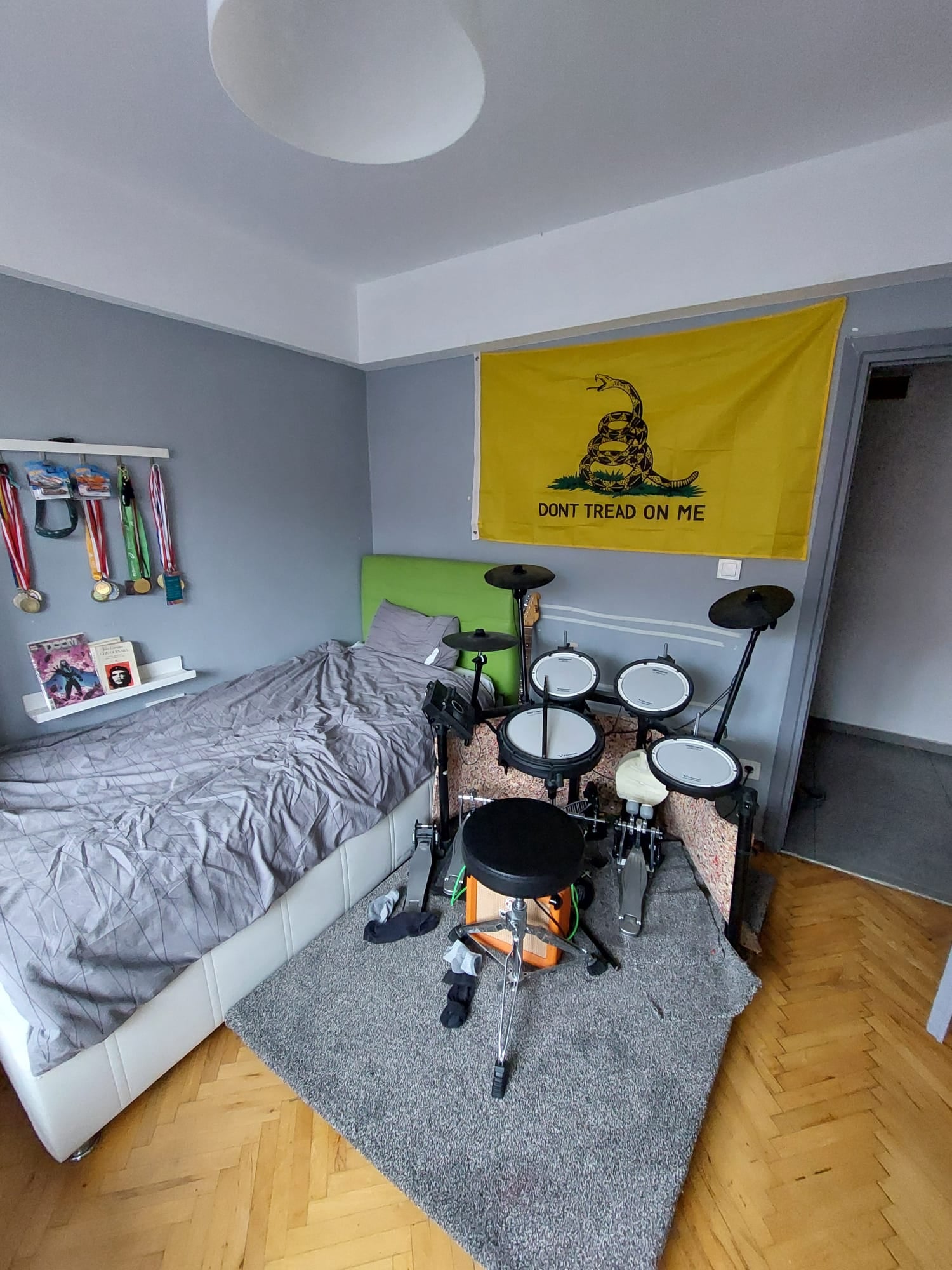To soundproof a ceiling in an apartment, consider adding mass-loaded vinyl and acoustic panels. Installing a drop ceiling with insulation can also reduce noise transmission.
Dealing with upstairs noise can be a challenge in apartment living. Soundproofing your ceiling is a viable solution to create a peaceful environment. An effective soundproofing strategy involves materials that block or absorb sound. Mass-loaded vinyl (MLV) is a dense, thin rubber-like material that can be added to ceilings to dampen sound vibrations.
Acoustic panels, often made of foam or fiberglass, can absorb sound waves, preventing them from bouncing around the room. Another option is to install a drop ceiling, which creates a space between the existing ceiling and the new surface where insulation can be placed to further muffle sounds. Combining these methods can significantly improve the acoustics of your apartment, ensuring a quieter and more serene living space.
Introduction To Ceiling Soundproofing
Introduction to Ceiling Soundproofing is key in a peaceful apartment. Loud noises from above can disturb your peace. Soundproofing your ceiling can block these noises. This guide will explain why soundproofing is important and common apartment noise issues.
Why Soundproofing Matters
Soundproofing your ceiling has big benefits:
- Improves sleep quality by reducing noise.
- Increases privacy between floors.
- Makes your home a calm space.
Common Noise Issues In Apartments
Apartments face many noise challenges:
- Footsteps from the above floor.
- Loud music or TV sounds.
- Conversations can easily be heard.
Understanding these noises helps in choosing the right soundproofing method.
Assessing Your Ceiling
Assessing Your Ceiling is the first step to a quieter apartment. It’s important to understand what type of noise you’re dealing with. By identifying the noise and its source, you can choose the best soundproofing methods. Let’s dive into the types of noise and figure out where they’re coming from.
Identifying Noise Types
Before tackling the noise, know what you’re up against. There are two main types:
- Airborne noise travels through the air. Think of voices or music.
- Impact noise comes from objects hitting surfaces. Think of footsteps above.
Determining The Source Of Noise
Next, find out where the noise originates. Use the following steps:
- Listen closely to pinpoint the loudest area.
- Check for gaps or holes in the ceiling.
- Notice if noise worsens at certain times.
Once you’ve identified the noise type and source, you’re ready for the next steps in soundproofing your ceiling.
Materials For Soundproofing
Materials for Soundproofing are key in reducing noise.
The right choice ensures peace in any living space.
Soundproofing Insulation Options
Insulation absorbs sound, preventing it from traveling.
- Fiberglass – Dense and effective for noise reduction.
- Mineral Wool – High-density material for sound blocking.
- Cellulose – Eco-friendly, made from recycled paper.
- Foam Insulation – Easy to install, great for filling gaps.
Sealants And Acoustic Panels
Sealants and panels add an extra noise barrier.
| Product | Use |
|---|---|
| Acoustic Sealant | Seals edges and gaps effectively. |
| Green Glue | Dampens sound between layers. |
| Acoustic Panels | Mounted on walls, absorbs echoes. |
Quick Fix Strategies
Living in an apartment often means dealing with noise from above. Quick fix strategies can help reduce that noise without major renovations. These fixes are simple yet effective.
Adding Mass With Drywall
Increasing the mass of your ceiling blocks sound. Here’s how:
- Add a new layer of drywall to the existing ceiling.
- Use soundproofing compound between layers.
- Ensure joints are tightly sealed.
- Finish with acoustic sealant for best results.
Using Acoustic Tiles
Acoustic tiles are a stylish option:
- Choose specialized acoustic tiles.
- Install easily with adhesives or clips.
- Arrange in attractive patterns for decor.
- Look for high NRC (Noise Reduction Coefficient) ratings.
Diy Soundproofing Techniques
Living in an apartment often means dealing with unwanted noise. But fear not! DIY soundproofing can transform your ceiling into a barrier against sound. Let’s explore some techniques that can help you achieve a quieter space.
Installing A Drop Ceiling
A drop ceiling can significantly reduce noise. It adds a barrier between your living space and the floor above. This ceiling is easy to install with a simple grid system and sound-absorbing tiles.
- Measure your ceiling area.
- Buy a drop ceiling kit and acoustic tiles.
- Follow the kit’s instructions carefully.
Remember to leave space for lighting fixtures. A drop ceiling not only cuts down on noise but also offers a modern look.
Creating A Layered Effect
Layers can dampen sound waves. You can create a layered ceiling by adding materials that block or absorb sound. Here’s how:
- Attach resilient channels to your ceiling joists.
- Place soundproofing panels onto the channels.
- Add an extra layer of drywall for more mass.
- Seal gaps with acoustic sealant for best results.
These layers work together to trap noise. Your ceiling becomes a shield, keeping your apartment peaceful.
Soundproofing On A Budget
Living in an apartment often means dealing with unwanted noise from above. But, tight budgets don’t mean you must endure this. Soundproofing doesn’t always require professional intervention or expensive materials. With some creativity and everyday household items, you can significantly reduce noise levels. This section will explore simple yet effective ways to soundproof your ceiling without breaking the bank.
Affordable Soundproofing Hacks
Cheap soundproofing solutions can make a big difference. Here are some hacks:
- Attach mass-loaded vinyl (MLV) to your ceiling. It’s a dense material that blocks sound.
- Install a layer of drywall for added mass. Use Green Glue to seal gaps and dampen sound.
- Consider acoustic foam panels. These can be glued to the ceiling and help absorb sound.
Utilizing Household Items
Don’t overlook items you already own. They can be part of your soundproofing project:
- Thick blankets or quilts can be tacked to the ceiling. They absorb echoes and muffle noise.
- Use bookshelves as a barrier. Fill them with books for added mass.
- Rubber mats can deaden sound. Place them above drop ceilings or hide under decorative fabric.
Hiring Professionals
Hiring professionals to soundproof a ceiling ensures quality results. Expertise and precision are crucial for a successful installation. Apartment dwellers often face noise issues. Professionals offer reliable solutions for a peaceful home.
When To Call The Experts
Some situations demand expert intervention. Consider these scenarios:
- Complex ceiling structures
- Insufficient DIY results
- High noise levels
- Lease restrictions on alterations
- Time constraints
Cost Vs. Benefit Analysis
Evaluating the investment in professional soundproofing is key. Experts may seem costly. Yet, the long-term benefits are significant. A table below compares DIY and professional costs.
| Aspect | DIY | Professional |
|---|---|---|
| Materials | Potentially lower quality | Higher quality |
| Time | Longer, personal hours | Quick, efficient |
| Performance | Variable | Consistent |
| Longevity | Less predictable | Generally longer-lasting |
| Cost | Lower initial investment | Higher upfront cost |
Quality soundproofing adds value to your space. It reduces noise stress. Peaceful environments contribute to well-being. Professional services may cost more. But, they deliver lasting results.

Credit: www.pinterest.com
Maintenance And Upkeep
Maintenance and Upkeep are key for lasting soundproofing in any apartment. Regular attention ensures your ceiling remains a barrier against unwanted noise. Understanding the needs for maintenance helps keep your living space quiet and serene.
Regular Checks And Balances
Consistent check-ups prevent small issues from growing. Look out for signs of wear or damage in your soundproofing materials. This could mean:
- Inspecting for gaps or cracks in the ceiling.
- Checking the state of acoustic panels or tiles.
- Ensuring seals remain intact around fixtures.
Address problems immediately. This keeps your soundproofing effective. Use a simple calendar reminder for regular inspections.
Long-term Soundproofing Health
Soundproofing requires ongoing care for the best performance. Consider these tips:
| Action | Benefit |
|---|---|
| Clean soundproofing surfaces. | Prevents dust build-up. |
| Refresh sealants as needed. | Maintains airtight barriers. |
| Update materials over time. | Ensures ongoing efficacy. |
Protect your investment. Keep your soundproofing working well for years. A professional evaluation every few years can help too.
Legal Considerations And Compliance
When planning to soundproof a ceiling in an apartment, it’s essential to consider legal aspects and compliance. This ensures your project aligns with regulations and maintains good relations with your landlord and neighbors.
Understanding Apartment Regulations
Before starting any soundproofing work, get familiar with your building’s rules. These regulations often outline what changes are permissible within your apartment. Review your lease agreement or contact your homeowner’s association (HOA) for guidelines.
- Check for specific clauses related to renovations or alterations.
- Look for quiet hours or noise level restrictions that could influence your soundproofing needs.
- Seek approval for structural changes, as these may affect the building’s integrity.
Ensuring compliance with these rules will help avoid legal issues and potential fines.
Working With Landlords
Landlord approval is key for any modifications to your apartment, including soundproofing your ceiling. A transparent approach can foster a positive landlord-tenant relationship.
- Prepare a soundproofing plan to present to your landlord.
- Highlight the benefits of soundproofing, like increased property value and tenant satisfaction.
- Discuss non-invasive options that won’t damage the property.
- Negotiate who will cover the costs and if it will affect your rent.
With your landlord on board, your soundproofing project can proceed smoothly, enhancing your living space without any legal hiccups.

Credit: hush.info

Credit: www.ikoustic.co.uk
Frequently Asked Questions
Can You Soundproof An Apartment Ceiling Yourself?
Yes, soundproofing an apartment ceiling can be a DIY project. Simple methods include adding mass-loaded vinyl, acoustic panels, or installing a drop ceiling. These solutions can significantly reduce noise without needing professional help. However, for optimal results, especially in severe cases, consulting with a specialist is recommended.
What Materials Are Best For Ceiling Soundproofing?
For effective ceiling soundproofing, materials like mass-loaded vinyl, acoustic foam, fiberglass insulation, and soundproofing drywall are highly recommended. These materials are known for their sound-absorbing and blocking capabilities, making them ideal choices for minimizing noise transmission through ceilings.
How Much Does It Cost To Soundproof A Ceiling?
The cost to soundproof a ceiling varies widely, depending on the materials used and the ceiling’s size. DIY projects might range from a few hundred to a couple of thousand dollars. Professional installations can escalate, costing several thousand dollars, especially for high-grade materials and larger areas.
Is It Worth Soundproofing An Apartment Ceiling?
Yes, soundproofing an apartment ceiling is often worth the investment, particularly for those sensitive to noise or living in bustling urban areas. It enhances living quality by significantly reducing noise pollution, contributing to a quieter, more peaceful home environment.
Conclusion
Wrapping up, effective ceiling soundproofing can transform your apartment into a tranquil haven. Implementing the strategies discussed will minimize noise, ensuring peace and comfort. Take that step towards a quieter home today; the serenity you’ll gain is well worth the effort.

